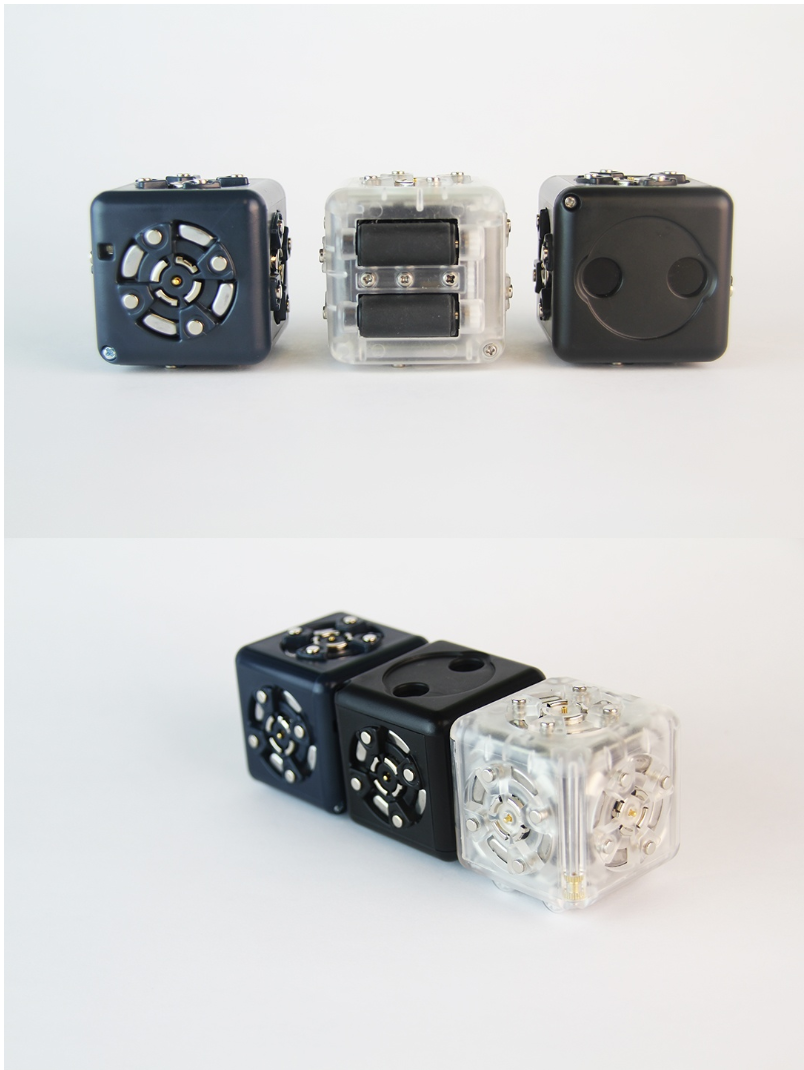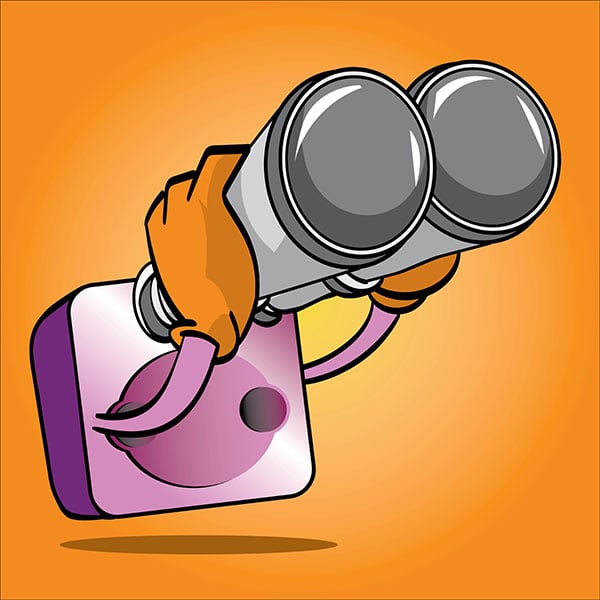Lesson Modules
Teaching Tips:
This lesson plan relates robots sensing to humans' ability to sense and react. Because this activity directs students to think about their sensing and feeling, it is ideal for introducing younger students to robotics. Cubelets present the Sense, Think, and Act components of a robot in a discovery‐based format that facilitates making connections between human senses and robotics while students play.
For each class/group, this lesson plan includes two parts:
Each segment is suggested to last 20 minutes for a total of 40 minutes of class time.
- An “unplugged” section highlighting sensing and sensory information
- A hands‐on exploration of robotics components using Cubelets
Each segment is suggested to last for 20 minutes, for a total of 40 minutes of class time. For class periods that are shorter than 40 minutes, we recommend increasing the time for each segment and using Part 1 as a single class activity and Part 2 as a single class activity the next day.
While these lesson plans have suggested age levels, it is also possible to use the younger student activities as a ramp up for older grades; e.g., use the 4‐8-years-old activities to ramp up and extend a lesson plan for a group of 9-year-olds. Similarly, the activities suggested for older students can serve as a way to expand on challenges presented to younger learners if there are time and interest.
Introduce each group to the concepts of senses and sensory input:
Tell the class: “Sensing is when we get information about things around us from our bodies like touching something rough or smelling something good. What other senses do we have? (Try to get students participating by naming their senses ‐ sight, hearing, touch, taste, smell.) What parts of our bodies do our sensing? What do we use to see? What do we smell with? We sense things, animals sense things, and today we’re also going to discover how robots sense. First, let’s think about how senses work by testing our own senses and find out more about robot senses.”
Depending on the writing skills of the students, let them tell their answers out loud.

Sensing is when we get information about things around us from our bodies like touching something rough or smelling something good.

We sense things, animals sense things, and today we’re also going to discover how robots sense. First, let’s think about how senses work by testing our own senses and find out more about robot senses.
Teaching Tips:
In this introduction, students will think about how they process changes in sensory information and realize that their senses are not binary (on/off) but have the ability to perceive a spectrum of more or less input. Students will investigate the results of receiving sensory information from more than one source. “We’re going to play a game where you have to use your ears to decide if you should act. “
Materials: radio or MP3 player/computer and speakers
Basic rules
- When students hear music, they should wave their hands in the air. Louder music = more waving, Softer Music = less waving
- When students hear clapping, they should sit down (No clapping = stand up)
- We sense more than one thing at one time. When students hear clapping and music, they should sit and wave their hands. If it’s just music, then they should stand up and wave their hands. If there’s just clapping, they should just be sitting.
- Simon says rules (may) apply! You can have your kids keep practicing different combinations, or you can impose an “out” if they wave hands when there is no music or they forget to sit. Last person playing is the winner and gets a prize (being first to test their robot, a sticker, etc.)
Suggested game progression
- “Our senses collect information about what’s going on around us. For this game, let’s use our ears to collect information. The first rule of this game is to wave our arms if we hear music. Everyone finds a spot with room around them so that there’s no touching. I’m going to play something, and when you hear it, you should wave your arms. “ (Play music)
- “Our senses can also tell if there’s a small amount of information or a large amount of information. One example is how we can hear big noises and small noises. When I play music, listen for a change in HOW MUCH you can hear. If it gets louder, wave your arms more. If it gets quieter, wave your arms less.” (Play music, changing the volume up and down.)
- “But, did you know that with our senses, we can collect information on more than one thing?. Now, If I clap, you should sit down as long as I’m clapping. Let’s practice.“
- “What do you think should happen if I am clapping AND playing music? (Sitting down but waving hands). And what should happen if you’re sitting down and I STOP clapping? (Stand up!) And what happens if the music stops? (Stop waving hands) And what happens if the music gets loud? (Wave hands more!) And what happens if it gets quieter? (Change and wave hands less)”
Let’s Play!
We’re going to play a game where you will need to use your ears to decide if you should act.
Basic rules
- When you hear music, you should wave your hands in the air.
Louder music = more waving
Softer Music = less waving
- When you hear clapping, you should sit down (No clapping = standing up)
- We sense more than one thing at one time. When you hear clapping and music, you should sit and wave your hands. If it’s just music, then you should stand up and wave your hands. If there’s just clapping, you should just be sitting.
- You can keep practicing different combinations, or your teacher can impose an “out” if you wave hands when there is no music, or forget to sit. The last person playing is the winner and gets a prize.
Suggested game progression
- Our senses collect information about what’s going on around us. For this game, let’s use our ears to collect information. The first rule of this game is to wave our arms if we hear the music. Everyone finds a spot with room around them so that there’s no touching. Your teacher is going to play something, and when you hear it, you should wave your arms.
- Our senses can also tell if there’s a small amount of information or a large amount of information. One example is how we can hear big noises and small noises. When your teacher plays music, listen for a change in HOW MUCH you can hear. If it gets louder, wave your arms more. If it gets quieter, wave your arms less.
- But, did you know that with our senses, we can collect information on more than one thing? Now, if your teacher claps, you should sit down as long as your teacher is clapping.
- What do you think should happen if your teacher is clapping AND playing music?
- What should happen if you’re sitting down and your teacher STOPS clapping?
- What happens if the music stops?
- What happens if the music gets loud?
- What happens if it gets quieter?
Let’s Play!
Teaching Tips:
Students work to understand what and how their robots sense. They are also exploring how changes and magnitudes of sensory information are detected
Materials: KT06 kits, groups of 14 students using each kit. Initially, all groups use only the Distance, Drive, and Battery Cubelet
Tell the class: “Robots are computers that can sense, think, and act. Our robot senses are in these black sense cubes. Our robot action parts are in these clear cubes. All robots need power. The gray blocks are the battery or power blocks. The simplest robot we could make here has to have at least 1 black cube and 1 clear cube joined with a battery. I’m going to make our first robot using these three Cubelets (Demonstrate with Battery, Distance, and Drive, in that order) Now let’s see what we can find out about this robot sense.”

Class investigation. “Let’s think about what it is sensing by seeing what makes the robot stop and what makes it go. What should we try? Does anyone have an idea of what our robot is sensing? Let’s hear your ideas and test them out. What could our robot be sensing? Take turns raising your hands with a suggestion and then you can come up and test it out. “ (Prompt students to try different ideas ‐ can they clap for it? Tell it to move? Help them notice that whenever they come close to the black Sense Cubelet the robot moves! ) “Remember, robots might be sensing different things than humans sense.”
You will work to understand what and how your robots sense.
Robots are computers that can sense, think, and act.
Our robot senses are in these black sense cubes.
Our robot action parts are in these clear cubes. Also, all robots need power, and the gray blocks are the battery or power blocks.
The simplest robot we could make here has to have at least 1 black cube and 1 clear cube joined with a battery. Your teacher will make our first robot using these three Cubelets. Now let’s see what we can find out about this robot sense.

Now that you’ve seen your teacher build a robot, use the same three Cubelets and see if you can build a robot that works.
- Heat
- Light
- Distance
Teaching Tips:
At this point, take two student volunteers (or two groups) ask them to explain how their robots works and their reasoning behind what their choices.
If time permits, discuss the benefits of using sensors.
Depending on the writing skills of the students, they can share just out loud their answer.

